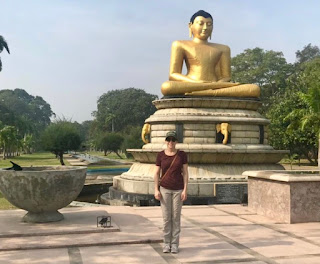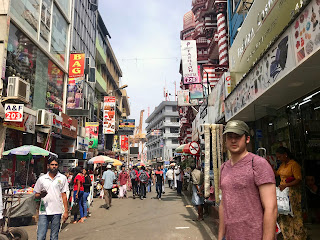Finding Our Footing in Colombo
Hello from Sri Lanka!
I had anticipated
that my first blog entry would discuss an exciting layover in Guangzhou, but in
a classic, confused-traveler moment at the Chinese airport, our temporary visa
request to spend a half-day in the city was denied. No explanation, no nothing!
The immigration official simply handed Matt our passports and stated that we
weren’t allowed to leave the airport. We brainstormed the many possible reasons
for this: Was our layover deemed too short to warrant the temporary permit? Did
the denial have to do with changing diplomatic relations between China and the
US? We’ll never truly know. Regardless, we spent nine hours hanging out in the
strangely empty yet massive Guangzhou airport, snacking on dumplings and moving
from one hard plastic seating area to the next.
Despite
that initial hiccup, our travel was smooth. We arrived in Colombo, exchanged dollars
for rupees, bought Matt a SIM card for his iPhone, and easily hailed an Uber to
our AirBnB. We “splurged” ($28/night) for a nice studio apartment for four
nights in Colombo, knowing we would want a quiet, relaxing place to unwind and
re-coop from days of travel. It’s been the perfect set-up. Check out this link to see the listing for
our AirBnB.
After a
choppy night of jetlag-ridden sleep, we were energized about exploring Colombo.
For those who are less familiar, Colombo is the largest city in Sri Lanka and
the country’s economic capital. It is located on the western coast of the teardrop-shaped
country, and has a 2,000+ year history as a trading hub. Because of Sri Lanka’s
dynamic colonial history, Colombo’s buildings are diverse in their architecture
and the food is an interesting blend of various cuisines. It’s been relatively
hot and dry since we arrived, reaching the high 80s in the afternoons. Colombo
is very unique because it is ethnically and religiously diverse—about 31% Muslim,
31% Buddhist, and 23% Hindu. This diversity is obvious everywhere you look, as
religion is a prominent element of Sri Lankan society and there are many houses
of prayer around Colombo.
On our
first day, Matt and I set out on foot—our favorite way to explore new places.
Considering we clocked in 22,000 steps on day one and 23,000 on day two(!), I
felt the title of this blog post was an appropriate one. We first walked
through Viharamahadevi
Park, which is sort of like Colombo’s version of Central Park with exercise
equipment, a lake with swan boats, walking paths, food stalls, and of course—a big
golden Buddha. We headed next to the National Museum,
which explores both the natural and cultural histories of the country and
houses large collections of tools, coins, artwork, and colonial artifacts from Sri
Lanka. I was especially interested in the agricultural history of Sri Lanka, and
Matt liked the original throne and crown from the Kandyan monarchs of Sri Lanka.
We paid a visit to the first Buddhist temple of our trip—the colorful and labyrinth-like
Gangaramaya Temple—and
finished the day with a stroll along the Galle Face Green, a large oceanside
park area with food stalls that often hosts local cultural festivals.
 |
| Golden Buddha in Colombo's Viharamahadevi Park. |
 |
| In front of the National Museum of Sri Lanka. |
 |
| Walking through the Gangaramaya temple. |
Day Two
in Colombo was also an active one. We first hailed a “Tuk-Tuk” via the Uber app,
if you can believe it! It was my first Tuk-Tuk ride—not Matt’s though. The
15-minute ride cost us just 75 cents. Check out this Wikipedia article
if you are less familiar with countries that rely heavily on auto rikshaws for
local transportation. These three-wheelers are absolutely everywhere in Colombo,
and many are hooked up to Uber or the Sri Lankan ride-hailing app, PickMe. We
were dropped up in the colonial “Fort” district, which
has a variety of sights listed in all the guidebooks including a clock tower,
light house, old Dutch hospital that is now a shopping center, the World Trade
Center, and the President’s House. Next, we visited the Pettah district of
Colombo, which was by far our most favorite of everything we have seen so far. This
historic area is chock-full of marketplaces—not the hokey tourist-trap kind,
but the authentic, bustling, crazy, pungent, crowded kind. We people-watched, examined
hundreds of kinds of vegetables and fruits that we had never seen before, wound
through crowded alleyways lined with crates of dried fish, and passed by colorful
mosques, temples, and churches that spoke to the diverse nature of Colombo.
One of
our favorite yet understated stops was the Wolvendaal Church on
the outskirts of Pettah, which bears tombstones from the 1600s, and has been a
Protestant home to people speaking Dutch, Burgher, Singhalese, Tamil, and English
over its history. Unfortunately, like many of the historic sites in Colombo,
the church has fallen into disrepair. We mused that if this church existed in
the US, it would have been re-painted, re-enacted, and monetized much like Mission
San Juan Capistrano or the Freedom Trail (both of which we recently visited).
Below are a handful of pictures from our second day in Colombo.
 |
| Colombo lighthouse in the Fort district. |
 |
| Walking the busy streets of Pettah. |
 |
| Spiciest meal I've ever eaten! The vegetarian lunch spread at Upali's restaurant included curried jackfruit, carrots, green beans, and red rice - all for 425 rupees (USD $2.33)! |
Matt and I have spent a lot of time discussing our initial perceptions of Colombo. We have enjoyed tasting the incredibly spicy foods, smiling at the friendly people who wave to us on the street, observing the adorable schoolchildren in uniform, and marveling at the vast amount of construction happening everywhere we look.
One of
the most challenging elements of traveling in Colombo, however, has been the air
pollution. A thick haze covers the city, and the poison air can be smelled and
felt in the back of our throats as we breath throughout the day. Matt had
experienced this phenomenon in China, but I had never been to a city so smoggy.
It’s a bit distracting and disappointing, especially when we consider the millions
of people who live here and endure this air quality every day.
We have
also thought a lot about the violence and civil unrest that plagued Sri Lanka—especially
Colombo—in recent decades. We consider the implications of years of war on the economy
and how conflict has hindered Sri Lanka’s ability to maintain historic sites
and improve infrastructure like sidewalks, signage, and public transportation
systems. We see so much untapped tourism potential here; it will be interesting
to see how the city develops over the next decade.
What a wonderful review! I feel as though I am there with you! So descriptive and well-written. I hope the energy keeps up throughout your journey! Hugs and love, Mom
ReplyDelete